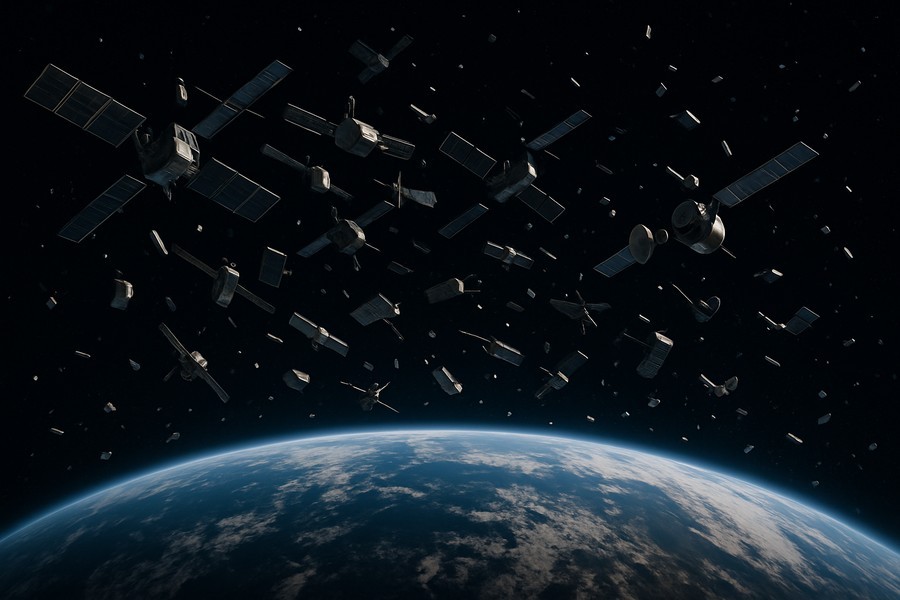
Space Traffic Jam: Alarm Raised Over Increasing Satellite Congestion
A recent investigation has revealed concerns about the potential overcrowding of orbital regions around Earth. The study suggests that the number of satellites navigating these congested paths could soon reach problematic levels.
Findings indicated that in 2019, a mere 0.2% of satellites performed more than 10 collision-avoidance maneuvers per month. However, by early 2025, the figure had risen to 1.4% - a sevenfold increase. This equates to around 340 satellites regularly engaged in evading debris and other spacecraft. While these numbers may appear small, they highlight an escalating problem.
Growth in Satellite Population
The number of objects, including both operational satellites and space debris, orbiting Earth has been on the rise. In 2019, there were about 13,700 objects in low Earth orbit (LEO), which is defined as altitudes below 1,200 miles (2,000 kilometers). By 2025, this figure had grown to 24,185 objects, marking a 76% increase. Predictions for the end of the decade suggest that we may see as many as 70,000 satellites in LEO, representing a more than fivefold increase from 2019.
Collision-Avoidance Maneuvers: A Growing Concern
Given the growing congestion, the researchers identified 10 collision-avoidance maneuvers per month as a critical threshold. Beyond this point, satellite operations could become overly complex and less effective. Satellite operators naturally prefer to focus on their primary tasks rather than constantly worrying about potential collisions.
Using data from the U.S. Space Command's catalog of space objects, the researchers calculated the collision likelihood for each pair of objects sharing the same orbital region. Whenever two objects came within 66 feet (200 meters) of each other, it was logged as an event requiring a collision-avoidance maneuver.
Spacecrafts' Collision-Avoidance Strategies
Different operators have varying thresholds for executing collision-avoidance maneuvers. For example, one major satellite operator with a vast broadband megaconstellation, maintains a proactive stance, using an autonomous system to avoid objects posing even a minimal collision risk. Other operators are a bit more flexible, especially those whose services are not significantly affected by minor changes in their orbits.
However, even with these precautions, collision-avoidance maneuvers are not fail-proof. Miscalculations can occur, and past research has shown that executing an avoidance maneuver can potentially increase the risk of a future collision. The more satellites in orbit, the higher the likelihood of a maneuver failing.
The Domino Effect of In-Orbit Collisions
Estimates suggest there is already a 10% chance of an in-orbit collision happening within the next year. A major satellite collision could generate thousands of new debris fragments, increasing the need for nearby operational spacecraft to execute more avoidance maneuvers and subsequently raising the likelihood of more collisions. This cascading risk is a significant concern for researchers and operators.
If this trend continues, we may reach full orbital capacity much sooner than expected. Consequently, it might be beneficial for satellite operators to rethink their launch strategies, particularly with regard to already crowded orbits, and perhaps coordinate their operations to minimize crossing paths.
Challenges to Global Coordination
While coordination sounds logical, implementing it on a global scale poses substantial challenges. Several countries, including potential adversaries, are planning to develop their own satellite constellations. Getting all these players to agree on a coordinated strategy might be an uphill task.
Despite these concerns, some operators seem to be managing the growing number of maneuvers effectively. For instance, one prominent satellite operator reportedly executed around 145,000 collision-avoidance maneuvers in a six-month period leading up to July 2025. This equates to roughly four maneuvers per satellite per month, a frequency they seem to handle well.
In conclusion, the study highlighted that certain orbital regions, particularly between the altitudes of 25 miles and 370 miles (400 to 600 km) and 435 miles and 500 miles (700 and 800 km), are more congested than others. Satellite operators may need to consider these findings and adapt their strategies to ensure safe and effective operations in the future.
